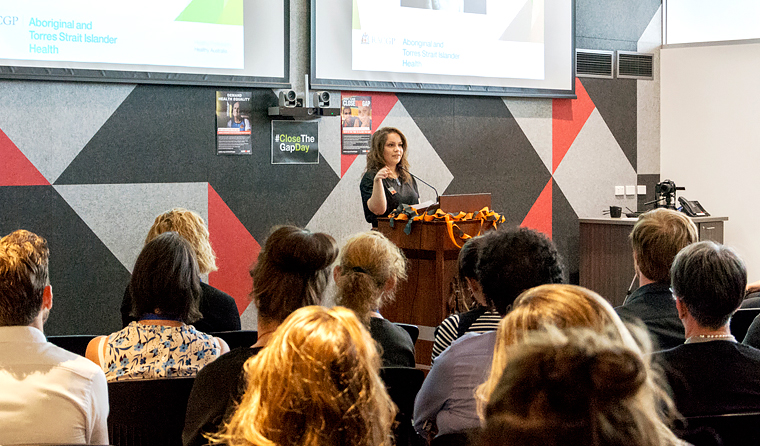News
Close the gap: Identity, culture and resilience
Close the Gap representative Banok Rind has urged all people in Australia to reflect on 10 years of efforts to address healthcare inequalities while speaking at the RACGP’s Close the Gap Day event in Melbourne.
 Barok Rind is a Yamatji-Badimia woman from WA, a registered nurse and strong advocate for the health of Aboriginal and Torres Strait Islander people.
Barok Rind is a Yamatji-Badimia woman from WA, a registered nurse and strong advocate for the health of Aboriginal and Torres Strait Islander people.
‘We walk alongside each other and walk towards change,’ she said to those in attendance. ‘The fact that we are sitting together in this room is a powerful and positive statement of change.’
Banok acknowledged there has been progress and many positive results in the decade since Kevin Rudd formally apologised to Australia’s Stolen Generations and pledged to close the health gap between Aboriginal and Torres Strait Islander people and non-Indigenous Australians. However, she also pointed to the fact that the gap has widened in many areas, and reinforced the idea that there is still much work to be done.
‘In the last 10 years, how far have we come?’ she said. ‘It’s a national urgency.’
 Banok called so many people coming together to reflect on a decade of working to close the gap ‘a powerful and positive statement of change’.
Banok called so many people coming together to reflect on a decade of working to close the gap ‘a powerful and positive statement of change’.
A nurse at Melbourne’s St Vincent’s Hospital, Banok spoke with newsGP about her experiences as an Aboriginal healthcare worker and the fight to eliminate healthcare inequalities in Australia.
A Yamatji-Badimia woman from Western Australia, registered nurse and strong advocate for the health of Aboriginal and Torres Strait Islander people, Banok feels the significance of Close the Gap Day extends far beyond any single occasion.
‘It is not just about a day where we acknowledge the gaps between Indigenous and non-Indigenous people; it’s also about reflecting on those gaps and using that reflection as a source of empowerment to reduce those disparities,’ she told newsGP.
Banok has experienced those gaps in her own life. Having once been told by a teacher that she couldn’t be a doctor and would grow up to be unemployed because she is Aboriginal, Banok has seen the statistics of Aboriginal health reflected within her own family, including an uncle who died after his meningococcal disease was misdiagnosed as a common cold. And, even after she defied her teacher’s prediction and made it to university at the Royal Melbourne Institute of Technology, Banok continued to experience those gaps during her training as a registered nurse.
‘I’ve gone on placements where I actually had to drop out because I was dealing with racism there,’ she said. ‘When I finished university and my nursing degree, the day I was about to start working at the main hospital, I did have mixed feelings – I was really scared, because I knew I would have to deal with racism.’
Despite such adversity, Banok has made it through every obstacle, graduating from her degree in 2017 and delivering a powerful speech at this year’s annual Close the Gap parliamentary breakfast in February. It is her determination to change the situation for her people that inspired Banok to choose healthcare as a profession.
‘Just looking at the state of health in my own family, my father’s siblings, there’s so many and every single one has diabetes or chronic health diseases,’ she said. ‘That, to me, was the reality of it and I wanted to be a part of changing that.’
Banok’s experience as an Aboriginal woman and healthcare worker has led her to believe that for change to take place there must be genuine partnership between Aboriginal and Torres Strait Islander peoples and non-Indigenous Australians.
‘A big one for me would be non-Indigenous people becoming more aware of the cultural aspects, whether it would be seeking cultural competency training or just having an open mind towards learning more about Aboriginal and Torres Strait Islander people,’ she said. ‘So learning from us, and we can learn from [non-Indigenous people].
‘It takes it back to that path of walking alongside each other in order to reach a bigger and brighter future.’
When thinking of that brighter future, Banok cites many positive factors, including strong leadership within the Aboriginal and Torres Strait Islander community, a range of programs and mentoring workshops, and growth in numbers of Aboriginal and Torres Strait Islander people studying and training in healthcare and other fields.
‘In 10 years’ time, I definitely see a lot more Aboriginal and Torres Strait Islander health workers, whether they’re working in Community Controlled Health Services or in mainstream public hospitals or private hospitals,’ she said.
When asked what it is that helps Banok and other Aboriginal and Torres Strait Islander people face adversity and work towards closing the gap, she has a clear answer.
‘Identity, culture and resilience,’ she said. ‘I can confidently say that every single Aboriginal and Torres Strait Islander person carries those things with them.
‘It’s who we’ve been for the last 60,000 years and we’ll always carry that; it’s something no-one can take away from us. We use our identity and culture as a source of strength.’
Aboriginal-and-Torres-Strait-Islander-health close-the-gap national-apology
newsGP weekly poll
Health practitioners found guilty of sexual misconduct will soon have the finding permanently recorded on their public register record. Do you support this change?